


1966
Popular Electronics
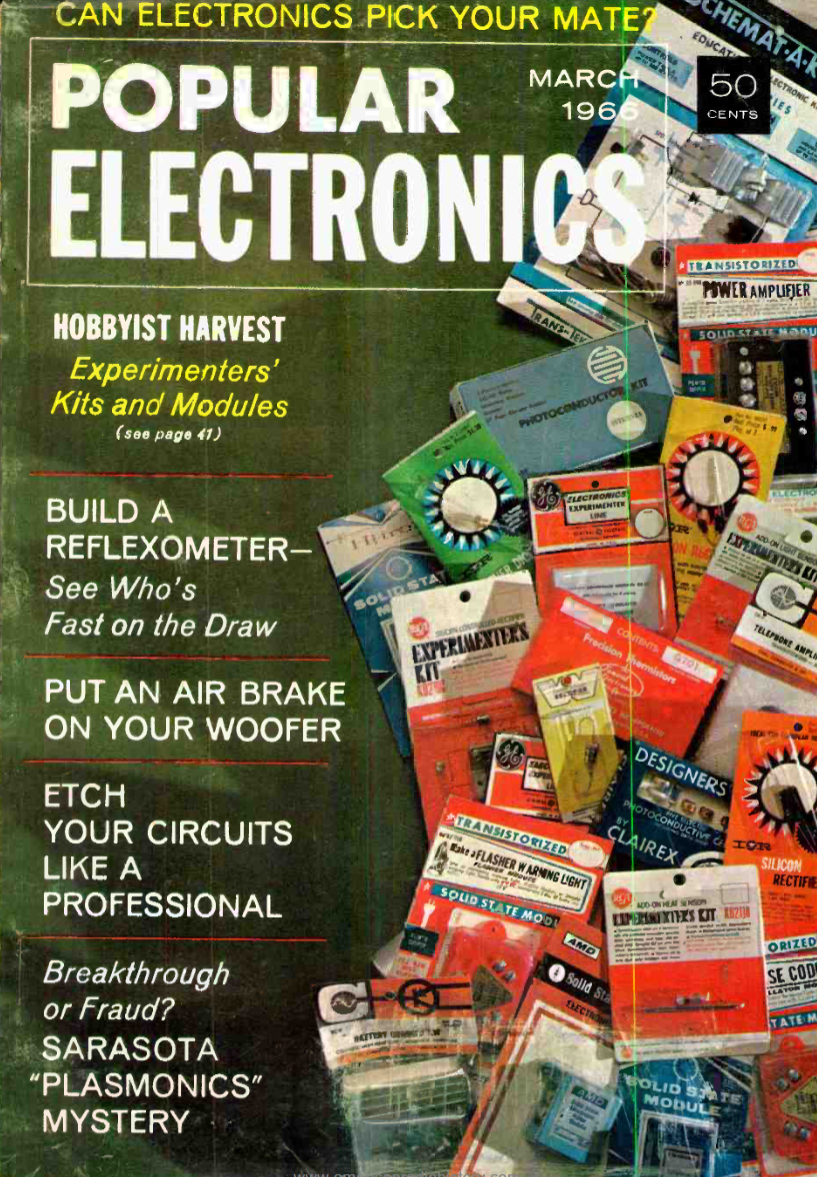 After reading Popular Science for the past few years and helping Dad
work on the TV, I was beginning to get interested in electronics.
TV’s were vacuum tube based at the time as I remember well from
helping Dad. Something would go wrong with the TV or as Dad would
say, “its acting up again.” Dad, being the handy man he was, would
pull the TV away from the wall, take off the back which had a
schematic of the set with tubes labeled like “Horz. Sync”, “Vert.
Sync”, “Amp.”, and so forth. From what was wrong with the picture,
Dad would choose one or more tubes, pull them out, and off we would
go to the 7-11 to test them, finding which one was bad and then
buying a new one. (see 1960)
After reading Popular Science for the past few years and helping Dad
work on the TV, I was beginning to get interested in electronics.
TV’s were vacuum tube based at the time as I remember well from
helping Dad. Something would go wrong with the TV or as Dad would
say, “its acting up again.” Dad, being the handy man he was, would
pull the TV away from the wall, take off the back which had a
schematic of the set with tubes labeled like “Horz. Sync”, “Vert.
Sync”, “Amp.”, and so forth. From what was wrong with the picture,
Dad would choose one or more tubes, pull them out, and off we would
go to the 7-11 to test them, finding which one was bad and then
buying a new one. (see 1960)
But times were changing, electronics were being revolutionized by
the invention of the transistor which I had been reading about in
Popular Science for a couple
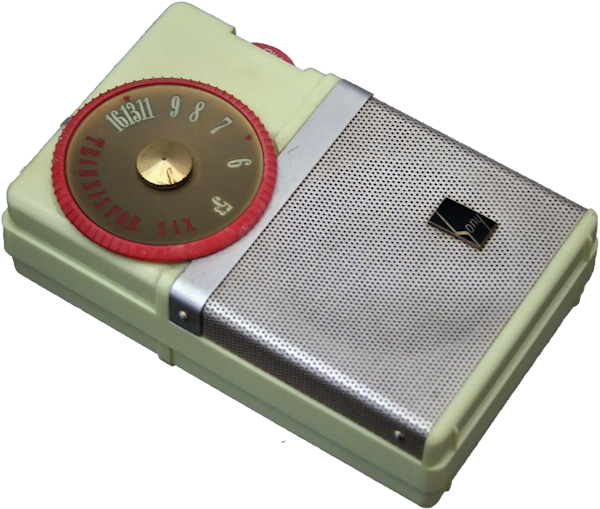 of
years now was transforming everything. The first pocket-sized
transistor AM radio in the US, the Sony TR-63, had only come
out in the US a few years earlier, although it was alleged that Sony
salesmen had shirts special made with larger pockets, and it cost
$39.95 (equivalent to $421 today). Newer models came out in 1963
and actually did fit in your pocket and the price came down
significantly.
of
years now was transforming everything. The first pocket-sized
transistor AM radio in the US, the Sony TR-63, had only come
out in the US a few years earlier, although it was alleged that Sony
salesmen had shirts special made with larger pockets, and it cost
$39.95 (equivalent to $421 today). Newer models came out in 1963
and actually did fit in your pocket and the price came down
significantly.
Color TVs had started outselling black-and-white TVs and screens size had grown to 25 inches but were expense, $300 to $1,000 ( $3150-$9,000 in today’s dollars). Some debated if color was worth it since most of the TV shows were black-and-white. While the big family room TVs were all still vacuum tube based, Popular Science had reviewed the latest transistorized TVs “Tiny TV Sets are In” saying how you will love them.
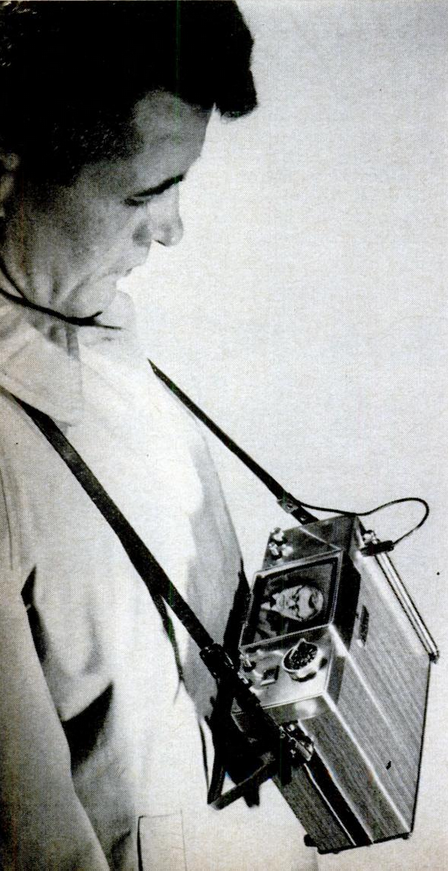
“What’s happening to the TV is the same thing radio went though. First we had only the bulky set in the living room. Then, with the development of the transistors and the art of miniaturization, radios shrank. You could carry one anywhere, even your it in your pocket. That’s what these tiny TV Sets are – personal. They let you watch your favorite show – in your bedroom, car, or boat, at the beach, on a picnic.”
Popular Science, Feb. 1965
With their cost $150 to $200 ($1,350-$1800 today) they were actually affordable.
With my interest in electronics growing, I browsed the magazine stand at the 7-11 where I found Popular Electronics magazine. Where Popular Science covered many subjects, Popular Electronics only was about electronics.
The transistor was here and available in 1966, I had to know more about them so the next time I went to the Library at Westwood I found they had books on electronics and how to make circuits using transistors. There were sections for Ham Radio, Television, Hi-Fi/Stereo, Science Fair Projects, and, what I found most interesting, a section on transistors and circuits. Each issue would provide details about how to build various kinds of small electronic devices, a binary counter, audio generator, and so on. The magazine was oriented for the hobbyist who wanted to build it themselves. There was the section “Solid State” that provided not only circuit diagrams but explained how the components and circuit worked. I was fascinated with it all and started getting Popular Electronics each month. Almost as good as the articles were the advertisements. There was always a full page ad for Heathkit which sold high end kits for ham radio, TV’s and other electronic devices always too expensive for me. Lafayette Electronics was more my level selling components as well as electronic devices. But there were dozens of others all of which you could order their free catalog. Even better the advertisements had a “Circle No. XX” on and the magazine came with a 3x5 card with all the numbers which you would circle, put you name and address at the top and put in the mailbox. A few weeks later the catalogs would start arriving in the mail. I did this pretty steadily for a few months and soon had a regular supply of catalogs coming each week.
My first electronic project was a crystal radio which is the simplest of radios, a coil of wire, a crystal and an earphone. I told Dad what I needed, and he said he could probably get it for me from the electronics shop at the Chemistry Department. The Chemistry Department had well equipped electronics supply room with a full time electronics staff person. I remember going there with Dad, the electronics supply room was in a small room off the interior courtyard of the chemistry building Leigh Hall. Dad opened the door to the electronics supply room which wasn’t much bigger my bedroom at home and found it full of shelves with all sorts of electronic equipment and parts. Sitting on a stool at the workbench was a man that Dad introduced me to named Dick McCurdy. I told the man what I needed, he said he could help and begin pulling this and that from a box or drawer until he soon had everything on my list. I thanked him, exited to get home to build my first radio.
When we got home, I got a cardboard tube from
a roll of toilet
 paper, wrapped wire around it and then made
connections to the crystal and other parts, connected the earphone,
stretched up the antennae and….nothing. Disappointed, I kept
trying, moving the radio closer to the window and slowly moving the
tuning arm finally heard it, the University of Florida’s WUFT
playing classical music. I wasn’t much into classical music at the
time, like it was what they played on old time movies, but hey, my
radio worked. I put the radio on the shelf next to my upper bunk
and would listen to it each night as I fell asleep.
paper, wrapped wire around it and then made
connections to the crystal and other parts, connected the earphone,
stretched up the antennae and….nothing. Disappointed, I kept
trying, moving the radio closer to the window and slowly moving the
tuning arm finally heard it, the University of Florida’s WUFT
playing classical music. I wasn’t much into classical music at the
time, like it was what they played on old time movies, but hey, my
radio worked. I put the radio on the shelf next to my upper bunk
and would listen to it each night as I fell asleep.
 One
Transistor Radio Circuit
One
Transistor Radio Circuit
One Transistor Radio Circuit Although the radio worked it was hard
to hear and only got one station, so I found a book on basic
electronic circuits in Westwood’s library where I found a circuit
for a one transistor radio. Electron circuit diagrams use symbols
that represent the components, transistors, speaker, capacitor so I
soon learned what the symbols represented. After another trip to see
Dick McCurdy, I got the components I needed. The circuit is simple
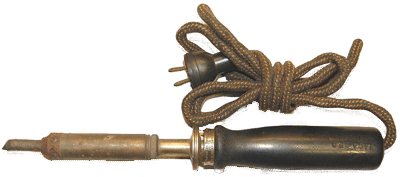 but did require the wires of the components to be soldered together
so Dad got me a soldering iron. A giant soldering iron, which I
think was used for soldering copper plumbing. Dad sat with me on
the floor of my bedroom and help me solder the wires together. Dad
also got me an old pair of headphones which was army surplus,
probably from Camp Blanding. The new
but did require the wires of the components to be soldered together
so Dad got me a soldering iron. A giant soldering iron, which I
think was used for soldering copper plumbing. Dad sat with me on
the floor of my bedroom and help me solder the wires together. Dad
also got me an old pair of headphones which was army surplus,
probably from Camp Blanding. The new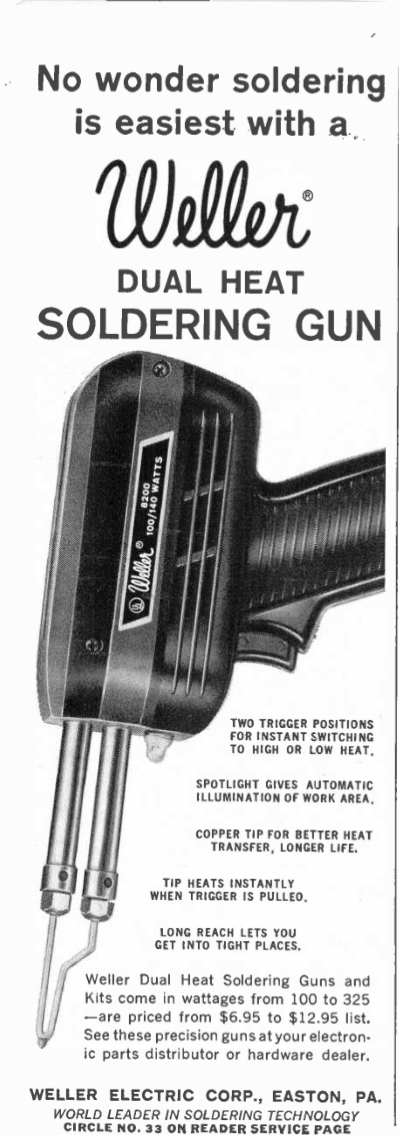 radio required 9 volt battery
which Dad got for me and behold it worked. Not only could I get
WUFT but now I could get one of the popular hit radio stations and
on some days a third one but not as clear. The radio again went on
the shelf next to my bed and I listen to it nightly as I went to
sleep. Well, if a one transistor radio was good then a two
transistor radio was better which I built next. I soon found that
the big old soldering iron dad got me wasn’t very good for soldering
small transistors and when I saw an advertisement for a Weller
soldering gun. It looked like a ray gun from a science fiction
movie, trigger
radio required 9 volt battery
which Dad got for me and behold it worked. Not only could I get
WUFT but now I could get one of the popular hit radio stations and
on some days a third one but not as clear. The radio again went on
the shelf next to my bed and I listen to it nightly as I went to
sleep. Well, if a one transistor radio was good then a two
transistor radio was better which I built next. I soon found that
the big old soldering iron dad got me wasn’t very good for soldering
small transistors and when I saw an advertisement for a Weller
soldering gun. It looked like a ray gun from a science fiction
movie, trigger switch, dual heat, wow, I thought, how much better it
would be than the big old iron that Dad got me. It was expensive at
$6.95 plus shipping, but I had to have it, so I My Weller Soldering
Gun order one and in a couple of weeks it arrived. I used it the
following years making increasing more complex projects, some from
kits, and still use it today.
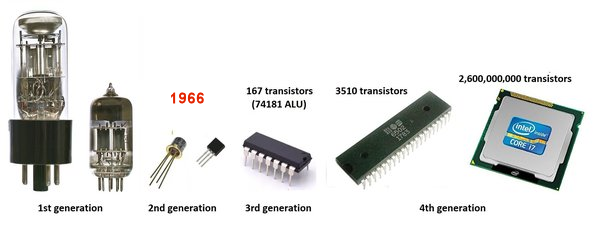
Evolution of Circuits
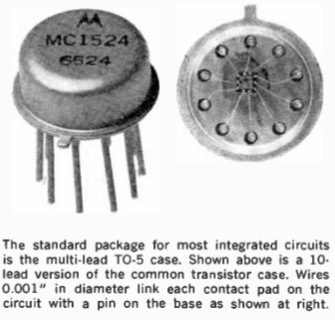 1966
IC
1966
IC
Although the transistor the present, Integrated Circuits were the
future and were just being introduced. In the October issue of
Popular electronics explained, “Integrated Circuits, There is a
bright future for a new technology in molecular electronics that
could make possible a new generation of productions for industry and
home.” The figure above shows transistors in 1966 then third
generation Integrated Circuit or just IC as they became to be called
but we weren’t there yet, we were on generation 2.5 with ICs only
having a dozen or so transistors and looked like a really big
transistor but was still smaller than the dozen transistors they replaced. Popular Science quickly started having
projects using the new ICs starting with IC amplifier with one IC
that replaced the equivalent of six transistors and was about the
size of a deck of cards, all for under $6. How cool was that!
transistors they replaced. Popular Science quickly started having
projects using the new ICs starting with IC amplifier with one IC
that replaced the equivalent of six transistors and was about the
size of a deck of cards, all for under $6. How cool was that!
Updated: 09-15-2022